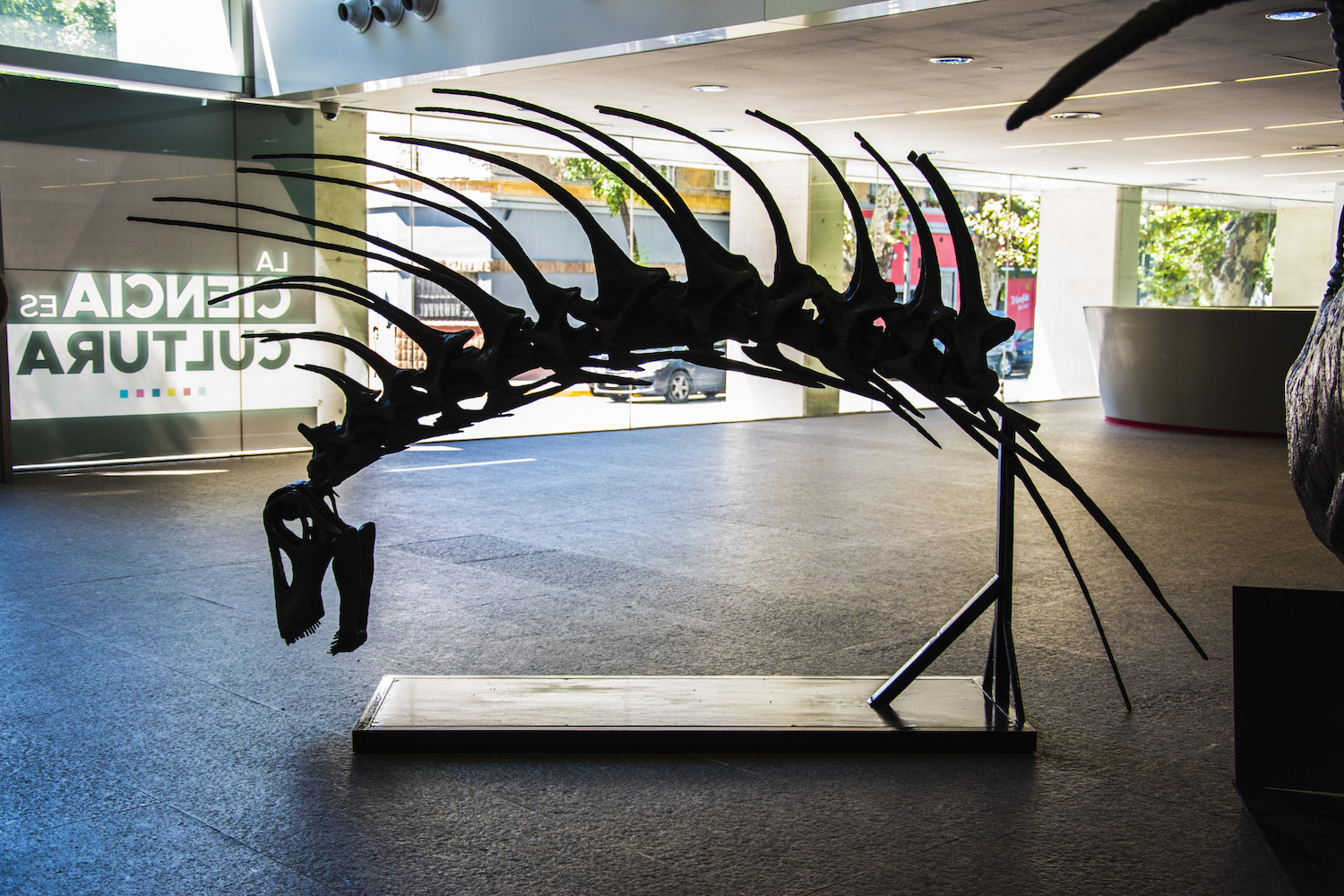 Evolution & Behaviour
Evolution & Behaviour
Back off predators!! Herbivorous dinosaur with spiny neck
The finding of Bajadasaurus pronuspinax allowed us to better understand the composition of the dinosaur fauna in the lowermost Cretaceous of Patagonia and to show that the evolution of a fence of long neural spines over the neck of these herbivorous dinosaurs was likely adaptive over at least 20 million years.

Sauropod dinosaurs, large herbivores with long neck and tail, include the largest terrestrial animals that ever inhabited the Earth such the giant titanosaur Patagotitan, or the colossal diplodocid Diplodocus. However, some groups of sauropods were not necessarily characterized by their size but by other anatomical features.
All these plant-eaters dinosaurs developed different strategies that allowed to defend themselves against predators. While for some dinosaurs the combination of large size and rapid growth kept them safe, others developed creative strategies such as whiplashes, armored skin or bone clubs at the tip of the tail. Most dicraeosaurid sauropods possessed a long and pointed double row of spines over their neck and back - their possible function has been the object of diverse conjectures in the last decades. These long spines were proposed as a support structure for a sail that would have regulated the body temperature. Other authors suggested that these spines formed a display crest that improved their communication or gave them sex appeal. It was also proposed that they could have had a dorsal hump to store reserves between the row of spines, and even as inner cores of dorsal horns with defensive function.
The first dicraeosaurid known was Dicraeosaurus found by Werner Janensch in Tanzania at the beginning of the 20th century, but the most representative was Amargasaurus, found by José Bonaparte in Argentinean Patagonia in the 80s. Amargasaurus, who lived 120 million years ago, is characterized by the presence of extremely long neural spines (around 80 centimeters tall) over its neck that pointed backward.
Since 2010, we are excavating in a locality called Bajada Colorada from northern Patagonia, Argentina. Here, the outcrop rocks date from 140 million years ago and, therefore, all the local fossils, represent an overview of a period of time poorly known in terms of dinosaur fauna and evolution from the southern landmasses. In this scenario, local fossils, from herbivorous to carnivorous dinosaurs, are also important to study, in the near future, the relationships between Jurassic's forms of life and the succeeding upper-cretaceous dinosaur groups.
In 2013, a handful of teeth and other striking bones were collected from a rock block (externally protected with bandages and plaster) and transported to the laboratory of El Chocén Museum. After months of cleaning and preparation by the technical staff, we recognized a nearly complete skull (the most complete skull of this group of sauropods) and few cervical vertebrae of the neck (that show extremely elongate bifid cervical neural spines that point forward) of a new species of dinosaur that we named Bajadasaurus pronuspinax. The generic name comes from Bajada (Spanish for downhill, in reference to the locality Bajada Colorada) and saurus (Greek for lizard). The species name from pronus (Latin for bent over forward) and spinax (Greek for spine), in reference to the anteriorly pointed, curved, neural spines of the cervical vertebrae.
The cranial bones, as well as the morphology of the cervical vertebra of Bajadasaurus, allow inferring the every-day life position of the neck and the head of this sauropod. The narrow and small teeth are restricted to the anterior portion of the jaws and the orbits are dorsally exposed. Hence, given their anatomy, these animals probably spent a good part of their life "grazing" over small plants at ground level. In this context, the fence of extremely long pointed neural spines could have been successful in deterring many predators. However, should these fragile bone structures have been covered only with some skin, they would have easily been exposed to fractures. That is why we think that they were probably protected by a keratin sheath (as for many mammals, which horns are composed by a keratin sheath-covered bone) that reinforced these delicate spines.
The finding of Bajadasaurus pronuspinax clarifies the composition of the dinosaur fauna in the lowermost Cretaceous of Patagonia. Moreover, it also shows that the development of Bajadasaurus' fence of long bifid neural spines is the result of adaptive evolution over a long period of time - not minor than 20 million years.
Original Article:
P. A. Gallina, S. Apesteguia, J. I. Canale, A. Haluza, A new long-spined dinosaur from Patagonia sheds light on sauropod defense system. Sci Rep 9, 1392 (2019)Edited by:
Massimo Caine , Founder and Director
We thought you might like
Blood from a golden stone: dinosaur discoveries within amber
Jan 10, 2020 in Evolution & Behaviour | 4 min read by W. Scott Persons , Philip J. Currie , Corwin SullivanMore from Evolution & Behaviour
Feisty fish and birds with attitude: Why does evolution not lead to identical individuals?
Aug 31, 2024 in Evolution & Behaviour | 3 min read by Lukas Eigentler , Klaus Reinhold , David KikuchiRudimentary form of syntax present in chimpanzees
Nov 29, 2023 in Evolution & Behaviour | 3 min read by Maël LerouxAn incredibly massive ancient whale skeleton reveals a new way to become a giant
Nov 27, 2023 in Evolution & Behaviour | 4 min read by Olivier LambertVikings and Migrants: Unravelling Scandinavia's Genetic Mosaic in the Viking Era
Nov 13, 2023 in Evolution & Behaviour | 3 min read by Anders Götherström , Ricardo Rodríguez VarelaEditor's picks
Trending now
Popular topics


